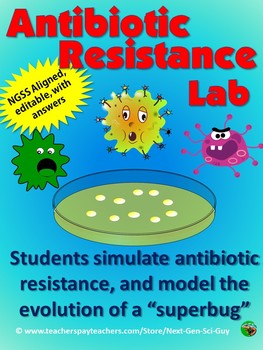Antibiotic Resistance Lab: Simulate the Evolution of a Superbug - NGSS
- Zip
What educators are saying
Description
In brief, students begin by answering an intriguing “bell ringer” (Powerpoint Slide included). Then, they simulate the use of an antibiotic on bacteria. The bacteria then mutates, requiring them to try an different antibiotic the following round. Finally, the two strains perform conjugations, and students try both antibiotics on the new strain, to no avail. They discover that a superbug has evolved. Students take data, graph the data, and analyze the data by answering post-lab questions.
A. NEXT GENERATION SCIENCE STANDARDS HEREIN
DCI’s: LS3.B: Variation of traits
LS4: Biological Evolution: Unity and Diversity
Cross Cutting Concepts: Patterns, Cause and Effect, Scale, Proportion and Quantity, Systems and Models, Stability and Change
Scientific and Engineering Practices:
Asking Questions and Defining Problems
Analyzing and Interpreting Data
Constructing Explanations and Designing Solutions
Developing and Using Models
B. SUGGESTED USES
Prior Knowledge: Students should have a foundational understanding of evolution by natural selection.
I Recommended Mezzi Paccheri or Paccheri Pasta to represent Bacilli bacteria.
"Evolution Unit Bundle" includes everything you need to teach a unit on Evolution, and its NGSS aligned.
Get it here: Evolution Unit Bundle
"Evidence for Evolution: Stations Lab" explores six lines of evidence that support evolution by natural selection. Each line of evidence is its own station, and students use inquiry to complete the lab.
Get it here: Evidence for Evolution Stations Lab
"Hacking Cladograms" is a student-centered activity that walks students through how to interpret, and create a cladogram.
Get it here: Hacking Cladograms
"Thinking Like Darwin" is a a good intro activity when teaching evolution, requiring students to make connections, and draw generalizations, about organisms that live in three different locations in the world.
Get it here: Thinking Like Darwin
"Speciation Activity" teachings students about several types of speciation, which has students model speciation in a frog population that is divided by a mountain range.
Get it here: Speciation Activty
Want students to construct a model of bacterial and eukaryotic chromosomes? Click the activity below:
Get it here: Modeling Prokaryotic and Eukaryotic Chromosomes
Implementing the Lesson:
Materials and Setup Per Pair:
1. A stopwatch (cell phone will work)
2. A paper cup
3. An unsharpened pencil – “Pencil-mycin” antibiotic
4. A clothespin – “Pin-a-cillin” antibiotic
5. A paper plates – Petri dish
6. 25 rigatoni pasta pieces – rod-shaped bacteria
7. 25 Cotton balls – spherical bacteria
8. 8 marbles – Multi-drug resistant spherical bacteria
I suggest the teacher begins the lesson with the “Intro Slide for Antibiotic Resistance” that comes with the download. The slide asks the students to consider an alarming hypothetical question about a “superbug”, which turns out to be a true story.
This rest of the activity is designed for students to be able to perform without too much help from the teacher. However, I am sure you will have to give a brief overview, and facilitate as the students encounter new terms and concepts.
Students must take data, graph data, and analyze it in post-activity questions.
I’ve included answers, with suggest point values for each task. All materials are editable.
Terms of Use
• This packet is 1 classroom/teacher use only. Do not make copies or
email it to your colleagues. This was designed by me and is for your
personal (one user)use. You may
not share it or claim it as your own. You may not redistribute it.
If colleagues are interested in it, please send them the link to my store:
https://www.teacherspayteachers.com/Store/Next-Gen-Sci-Guy
• You are not permitted to use any part of this work to
create products for sharing or selling.
• You are permitted to share the cover image of the packet
on your website when referring to it in a post, as long as
you link back to my store.
All rights reserved by author.



